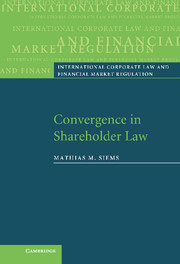Book contents
- Frontmatter
- Contents
- Preface and acknowledgments
- List of abbreviations
- Table of cases
- Table of legislation
- Introduction
- PART I The object and course of the investigation
- PART II The status quo of convergence
- PART III Developmental trends and patterns
- PART IV Conclusion
- 12 Convergence as a model for the future
- 13 Summary of principal findings
- References
- Index
13 - Summary of principal findings
Published online by Cambridge University Press: 15 December 2009
- Frontmatter
- Contents
- Preface and acknowledgments
- List of abbreviations
- Table of cases
- Table of legislation
- Introduction
- PART I The object and course of the investigation
- PART II The status quo of convergence
- PART III Developmental trends and patterns
- PART IV Conclusion
- 12 Convergence as a model for the future
- 13 Summary of principal findings
- References
- Index
Summary
As a summary, the theses set out in the introduction (in italics below) can be taken up again:
1. For shareholder law in the UK, the US, Germany, France, Japan and China, the division into different legal families is no longer a persuasive criterion of differentiation.
Both common features and differences today often cut across the division of legal families into common law, civil law and Asian law. General statements that for instance in the US and the UK shareholders are better protected and stakeholder interests irrelevant are accordingly to be rejected. Instead, in many sub-areas of shareholder law there are more differences of degree than structurally different conceptions.
2. Present shareholder law is based, internationally largely concordantly, on a basic pattern of codifications of company and securities law, supplemented by case law, articles of association, shareholder agreements and corporate governance codes.
While international and regional legal bases affect national shareholder law, this happens mostly in piecemeal fashion, so that it continues to be national sources of law that mostly matter. Here, in all the legal systems studied there are similar basic patterns. Abstract conceptions focusing only or mainly on one source of law have not been reflected in the present law. Nor is control through market forces relied on exclusively.
3. Although in Germany, France, Japan and China the reception of US law has increasingly expanded the investor aspect, all the legal systems studied here show a combination of the basic models of the shareholder as ‘owner’, ‘parliamentarian’ and ‘investor’.
- Type
- Chapter
- Information
- Convergence in Shareholder Law , pp. 396 - 400Publisher: Cambridge University PressPrint publication year: 2007



